What's Happening?
The Pentagon has reportedly restricted Ukraine from using U.S.-supplied long-range Army Tactical Missile Systems (ATACMS) to strike targets inside Russia. This decision is part of an effort by the Trump administration to encourage peace talks with Russian President Vladimir Putin. The restriction is enforced through a review mechanism developed by Elbridge Colby, the Pentagon's undersecretary for policy, which governs the use of U.S. long-range weapons. This mechanism also applies to Britain's Storm Shadow cruise missile, which relies on U.S. targeting data. The review process grants U.S. Defense Secretary Pete Hegseth the authority to approve the use of ATACMS, which have a range of nearly 190 miles. The decision comes amid concerns over the depletion of U.S. military ammunition stocks.
Why It's Important?
The restriction on Ukraine's use of U.S. missiles highlights the delicate balance the U.S. is trying to maintain in its support for Ukraine while managing its own military resources. The decision reflects a strategic move to potentially de-escalate the conflict by encouraging diplomatic solutions. However, it also underscores the challenges faced by the U.S. in maintaining its ammunition reserves amid ongoing global conflicts. The move could impact Ukraine's military strategy, as it limits their ability to strike deep into Russian territory, potentially affecting the dynamics of the conflict. This decision may also influence U.S. relations with European allies, who are involved in supplying weapons to Ukraine.
What's Next?
The Trump administration's approach suggests a focus on diplomatic efforts to resolve the conflict, with potential future negotiations between Russia and Ukraine. The U.S. may continue to evaluate its military support to Ukraine, balancing between aiding an ally and conserving its own resources. European nations may play a more significant role in supporting Ukraine, especially if the U.S. conditions further military aid on European financial contributions. The situation remains fluid, with potential shifts in U.S. policy depending on developments in the conflict and domestic political considerations.













